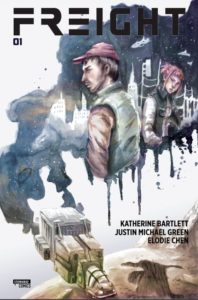
FREIGHT #1
Story & Letters: Justin Michael Green
Pencils, Inks, & Colors: Katherine Bartlett
Inks & Colors: Elodie Chen
Publisher: Stowaway Comics
A review by Michael Hein
 Two types of stories that continue to fit together seamlessly are tales of the disenfranchised underclass and tales of trade-based space travel. Something about that futuristic dream America has had since the sixties, made mundane by economic forces beyond our control still appeals to us, from Star Wars and Alien in the seventies to — well — Star Wars and Alien in 2017. Freight finds its home comfortably within this genre. It draws readers in with some familiar set pieces and motifs — beaten old space-trucks, inter-planetary stowaways, the loneliness of deep space — yet it promises more as well. Freight takes a genre which has endured the last fifty years or more for a reason, and puts it in a contemporary light.
Two types of stories that continue to fit together seamlessly are tales of the disenfranchised underclass and tales of trade-based space travel. Something about that futuristic dream America has had since the sixties, made mundane by economic forces beyond our control still appeals to us, from Star Wars and Alien in the seventies to — well — Star Wars and Alien in 2017. Freight finds its home comfortably within this genre. It draws readers in with some familiar set pieces and motifs — beaten old space-trucks, inter-planetary stowaways, the loneliness of deep space — yet it promises more as well. Freight takes a genre which has endured the last fifty years or more for a reason, and puts it in a contemporary light.
Freight #1 follows a melancholy space trucker and his unwelcome stowaway on a routine run from one planet to another. The writer — Justin Michael Green — offers a few lines of exposition on the inside cover, then trusts the reader to discover this world for themselves. The story is set in a time when Earth has colonized eight other planets, and the trade between them is vital. Green wisely plants this information, and leaves it at that. More than politics, the story is about a working class man in mourning and a girl from a broken home on the run. Green wastes no time in taking his reader in close to their perspectives and preparing us for their heroic journeys. On this count, however, the first issue doesn’t take us very far. In Freight #1’s twenty-seven pages, we only really reach the beginning of a narrative threshold. There’s nothing wrong with that, of course, it’s just a slower pace than one might expect from a self-published comic made on limited time and resources. It suggests that this issue was plotted thoughtfully, and there’s a lot more to come. It’s also a hint that this creative team is in it for the long haul, and they’re not sacrificing any of their vision just to get something made more easily.
At first glance, one of the most captivating things about Freight is the design work by Katherine Bartlett. As we know, one of the most intriguing and mysterious things about our favorite sci-fi stories is that the advanced technology in them often seems shabby and commonplace in context. Bartlett takes this common thread and runs with it. Owen Walker’s space truck — the central set of the issue — has a harsh, industrial feel to it, while somehow not sacrificing the wonderment of its lightspeed capabilities. Likewise, the weigh station, the docking bay, and all the other vehicles achieve a sense of space-age advancement, yet with a work-day mundanity. Bartlett succeeds in marrying this old-world sci-fi aesthetic to the age of computers and touch screens.
Though the vehicles, props, and world-building establish the grim tone of Freight, Bartlett’s overall style isn’t humorless. Her characters move and emote, and their utilitarian outfits convey their working class status as well as the story itself does. In addition, the cover is a beautifully painted piece that trails into the inside cover. It’s good that Bartlett’s art can hold the eye so well, as her characters haven’t yet been given much to do. The story is dramatic and enthralling, yet issue one is relatively short on visual action, for a comic book. Again, this shows the care that Green and Bartlett have taken in pacing their series out, but for the time being, Freight #1 consists mainly of stage-setting.
Verdict:
Buy it! I’m really looking forward to the rest of this series. Freight is the perfect kind of character-driven, unpretentious sci-fi that can transcend genre and medium to reach a wider audience. It reminds us why science fiction has a pop culture appeal and why it has become an enduring American tradition. You can purchase Freight #1 now on Comixology or directly from the Stowaway Comics website.



